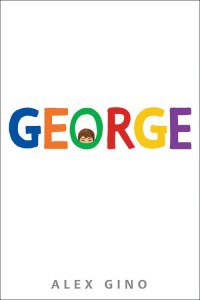“It’s true, and I have to say what’s true,” says Charlotte in Chapter 5 of E.B. White’s Charlotte’s Web. One can imagine the 10-year-old main character of Alex Gino’s debut middle grade novel George (Scholastic Press, August 2015) saying something very similar.
To everyone around her Melissa is a boy named George. But Melissa knows that she is a girl, a girl who would like to wear girl’s clothes, play with the girls at school, and be called Melissa instead of George. And it is becoming increasingly painful to keep that knowledge to herself, especially in the very gendered environment of grade school. As Melissa herself says, it’s hard pretending to be a boy. When Melissa’s fourth-grade class is to put on a play version of Charlotte’s Web, she is desperate to play Charlotte – not just because of her adoration for the wise and compassionate spider, but because if she could play Charlotte, maybe everyone, and most especially her mother, would see who she really is. But when her teacher refuses to let her audition for the part, all looks lost. Until her best friend Kelly gets the part — and hatches a plan.
While the device of the school play has been done before, in George it is put to perfect use, emphasizing Melissa’s hopes and dreams, and allowing her a safe vehicle for self-expression. Through well-fleshed out characters, George explores how even well-intentioned adults can be insensitive to the ways in which a transgender child might feel about themself and the larger world, and allows for surprisingly positive responses from some characters, while also showing how some may initially react with confusion, discomfort, and fear, even when they love the child. The novel does not gloss over how difficult those first steps toward telling other people can be for a transgender child, but, even in its honesty, it offers hope. Positive reinforcement for how the child needs those around her to react is especially modeled through the reactions of Melissa’s best friend Kelly, an insightful principal, and, surprisingly, Melissa’s tough older brother.
Gino’s direct and simple writing provides age-appropriate insights and clarity for what Melissa thinks and feels and wants. And their choice to tell Melissa’s tale in third person emphasizes in a really clear and striking way how it feels to be Melissa, knowing she is a girl and constantly being reminded that those around her see her as a boy. The narrative use of she and her and hers in referring to Melissa, while also continuing to use her given name of George, is an almost visual demonstration of how transgender kids experience the world, and it does so without tortured affectations or overly scholarly or after-school special explanations.
While Melissa’s efforts to be seen and to become her true self dominate the plot, George also includes many of the other elements common to middle grade fiction, such as dealing with parents, siblings, and school bullies, and navigating friendships during these constantly-changing years.
Overall, George is more than a much-needed addition to the books for younger readers that feature transgender characters. It is also a hopeful, joyful celebration of what it means to want to be true to yourself. Anyone who has ever felt different or misunderstood will feel for Melissa and root for her. And, in its own way, George is a very special tribute to the simple and brilliant honesty of Charlotte’s Web.
Note: An earlier version of this review was published here on May 21, 2015.

3 comments for “Review: George by Alex Gino”